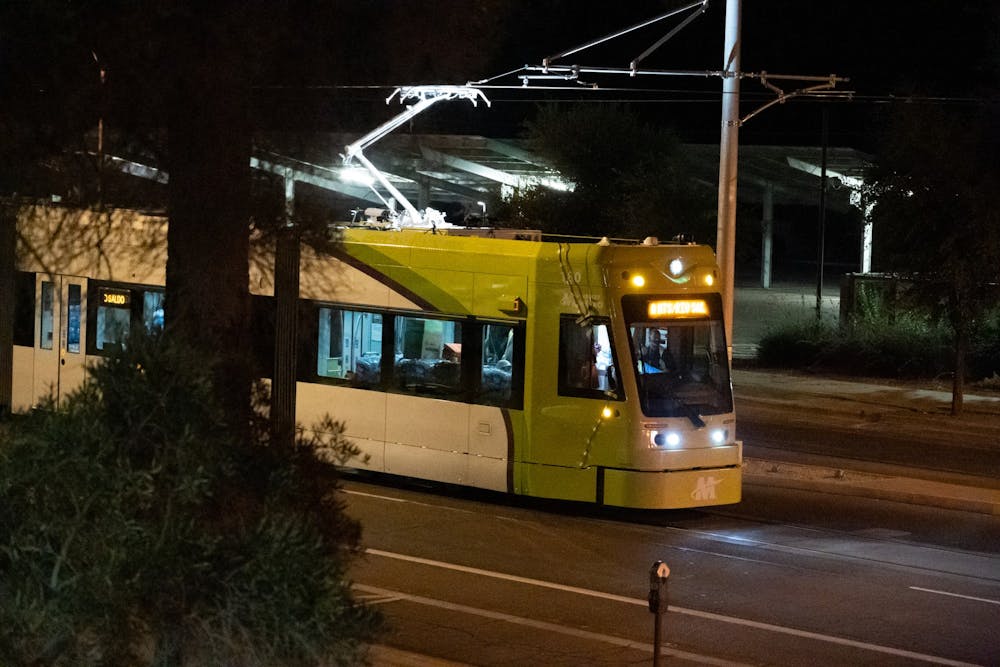The Tempe Streetcar will begin service in early 2022 after delays in the manufacturing and delivery of six vehicles made by Brookville Equipment Corporation. The $200 million project will include three miles of track, 14 stops and two connections to the already existing Valley Metro Rail.
The project, originally projected to be completed in mid-2021, is a collaboration between the city of Tempe and Valley Metro originating from a voter-approved regional transportation plan in 2004. The project is jointly funded by ASU, the Federal Transit Administration, a half-cent sales tax approved by Tempe voters in 1996 for transit expansion and a mix of private investors.
The Tempe Streetcar will share space with cars along its three-mile route between Hayden Butte Preserve and Dorsey Lane.
''There's a lot of opportunities to enhance connectivity in the city of Tempe,'' said Jessica Parks, the community outreach coordinator for Valley Metro. ''When developing high-capacity transit like this, it really does boost the economic potential of the region."
A report conducted by Columbia University in 2016 concluded that planning priorities for streetcar projects such as accessibility for low-income and underserved communities are often overlooked in favor of economic development.
David King, an assistant professor at ASU's School of Geographical Sciences and Urban Planning who was the principal investigator for the Columbia University report, said modern streetcars weren't designed to improve public transportation but to drive an area's economic development.
King is a member of Tempe's Transportation Commission, but said he was prohibited from commenting on the Tempe Streetcar specifically or on behalf of the city. King said when he joined the commission, the streetcar project had already been approved for construction.
''Streetcars in the United States are not intended to be transit,'' King said. "I have read through the justifications, the cost-benefit analyses, and the environmental reviews. They are about spatially targeting economic and land development."
The Tempe Streetcar is one of many streetcar projects that have taken place nationwide over the past decade. Some projects, such as the Portland Streetcar, have boasted high ridership coupled with boosted economic development in the city's surrounding areas.
However, other projects such as the DC Streetcar in Washington, D.C., and the Atlanta Streetcar have faced heavy criticism for high development costs, failure to provide meaningful transit benefits and low ridership.
King explained the poor implementation of projects in the U.S. is to blame rather than the technology itself, citing successful systems in Europe and Canada.
''If you want people to use transit, you make it useful and reliable,'' King said. ''If you give a mode dedicated space and frequent service, people will use it. You could do it with a streetcar or a horse-drawn carriage; it doesn't matter.''
King mentioned the accompanying infrastructure is ultimately responsible for a successful mode of transit and that reconfiguring the allocation of street space is essential for successful public transportation systems in the U.S.
''Cities are not having the hard discussions and making the difficult choices about how to take space away from cars,'' King said. ''They're trying to add things like bike lanes and streetcars, but streets are fixed and aren't getting any bigger. We are reinventing the original sin that took away streetcars in the first place.''
Samuel Stevenson, the interim deputy of transportation for the city of Tempe, expressed the city's ongoing commitment to the streetcar, including its expansion and upgraded fare collection systems.
''People love their cars; we weren't built as a dense urban center, and there are many challenges from our climate to our low density that are detractors from transit,'' Stevenson said. ''If we want our transit system to be an important and well-adopted part of our urban fabric in Tempe, we also have to develop in a way that allows people to use transit."
Stevenson explained the fare would be free for an unspecified amount of time while an upgraded ticketing system would be developed.
''Streetcars in the U.S. are a very expensive way not to enhance transit,'' King said. ''They do come with a host of land-use and real estate development improvements though. There hasn't been a lot of research on what the overall contribution of streetcars to development improvements is.''
King explained that streetcars are an example of spatial planning — favoring a particular area for development through infrastructure.
''Are streetcars the right tool for that, or is there a better tool?'' King said. ''Maybe you don't have to invest the hundreds of millions of dollars for a streetcar system. Maybe you can just change the zoning and improve the sidewalks.''
Reach the reporter at wstuart1@asu.edu and follow @wjstuart01 on Twitter.
Like The State Press on Facebook and follow @statepress on Twitter.
Continue supporting student journalism and donate to The State Press today.




